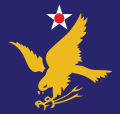514th Flight Test Squadron  | |
|---|---|
 A 514th Flight Test Squadron F-16 Fighting Falcon takes off from Hill Air Force Base 15 December 2010 | |
| Active | 1942–1946; 1947–1951; 1951–1965; 1970–present |
| Country | |
| Branch | |
| Role | Flight testing |
| Part of | Air Force Materiel Command |
| Garrison/HQ | Hill Air Force Base, Utah |
| Motto(s) | Quaerite Optimum Latin Seek the Optimum [1] Go, We Pave the Way (1957–1965) [2] |
| Engagements | Mediterranean Theater of Operations Korean War |
| Decorations | Distinguished Unit Citation Air Force Outstanding Unit Award |
| Insignia | |
| 514th Flight Test Squadron emblem [a] [1] |  |
| Patch with 514th Bombardment Squadron emblem [b] [2] |  |
| 514th Bombardment Squadron emblem (World War II) [3] |  |
| Aircraft flown | |
| Fighter | F-16 Fighting Falcon |
| Transport | C-130 Hercules |
The 514th Flight Test Squadron is a squadron of the United States Air Force, which has been stationed at Hill Air Force Base, Utah since 1973, performing functional flight checks on aircraft undergoing major maintenance.
Contents
- Mission
- History
- World War II
- Weather reconnaissance
- Strategic Air Command
- Flight testing
- Lineage
- Assignments
- Stations
- Aircraft
- Awards and campaigns
- See also
- References
- Notes
- Bibliography
The first predecessor of the squadron was formed as the 514th Bombardment Squadron in the Middle East in 1942 to reinforce the Royal Air Force in North Africa with personnel and aircraft diverted from delivery to the China Burma India Theater. The squadron moved forward, eventually being stationed in Italy, where it participated in the strategic bombing campaign against Germany, and was awarded three Distinguished Unit Citations for its combat actions. Following V-E Day, the squadron returned to the United States, where it converted to Boeing B-29 Superfortress bombers, but was inactivated in March 1946.
The squadron was redesignated the 514th Reconnaissance Squadron and activated in 1947 as a weather reconnaissance unit. It continued the reconnaissance mission until February 1951, when it was inactivated and its assets transferred to another squadron. The squadron returned to the bombardment mission later that year, and upgraded to jet Boeing B-47 Stratojet bombers in 1954. It continued to fly the Stratojet until they were phased out of the Air Force inventory, and the squadron was inactivated in 1965.
The squadron's second predecessor was organized as the 6514th Test Squadron at Edwards Air Force Base in 1970 to test unmanned aerial vehicles. It moved to Hill in 1973 and assumed its current mission. The two squadrons were consolidated in 1992 as the 514th Test Squadron









